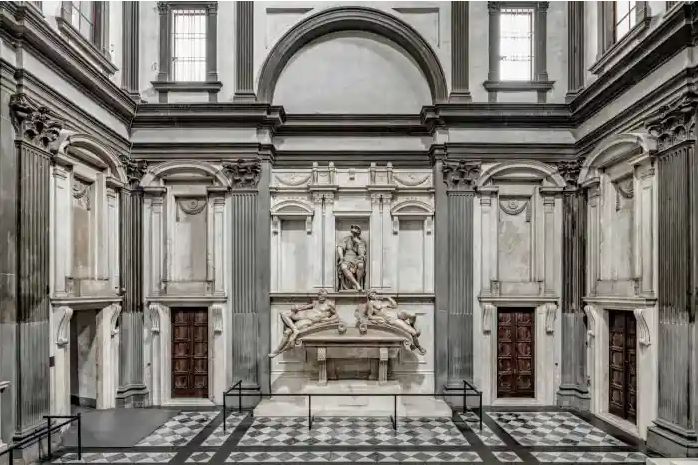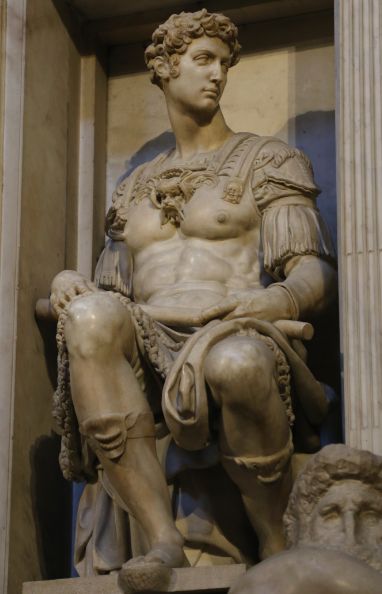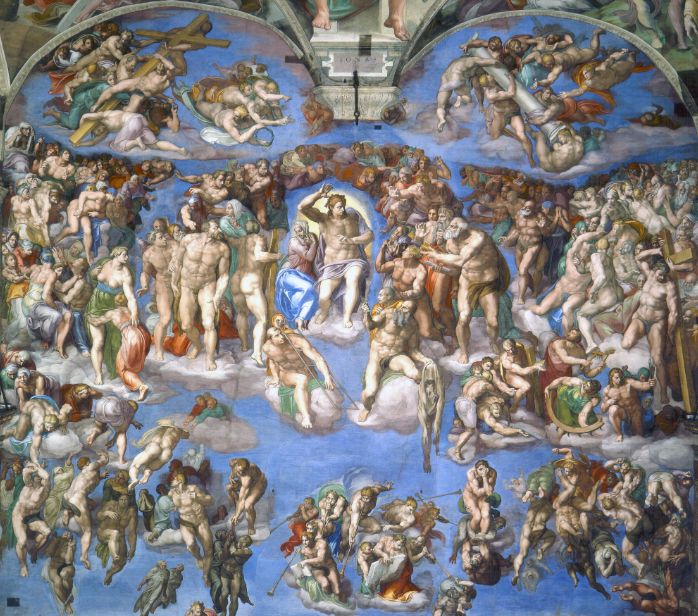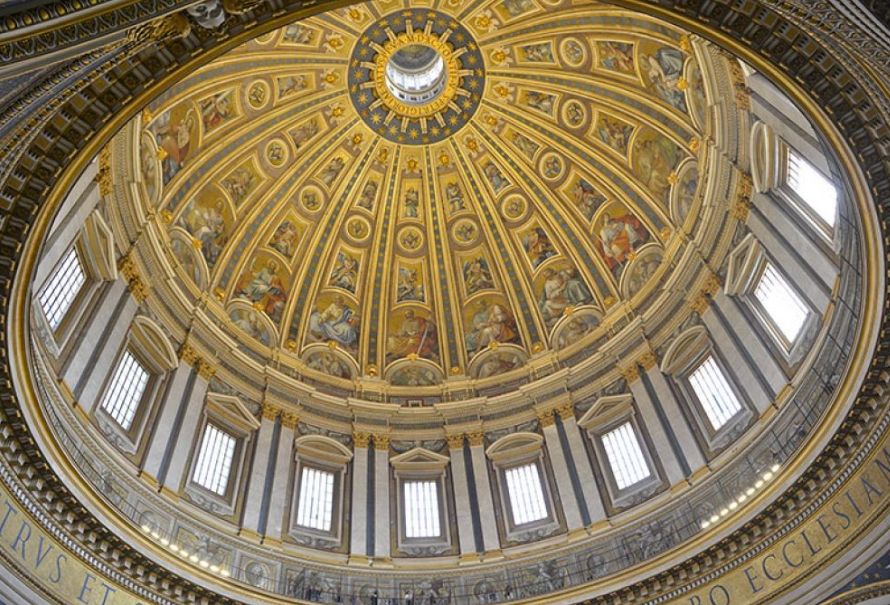After completing the Sistine Chapel ceiling, Michelangelo returned to Florence. By this time, the Medici family had regained power in 1512 and further consolidated their influence with the election of a Medici pope, Leo X (1513-1521). Now, they were the rulers of central Italy. The new pope and his cousin (later Clement VII, 1523-1534) began transforming the Church of San Lorenzo into a dynastic memorial and commissioned Michelangelo to design a new façade (which was never built) and a family tomb, known as the Medici Chapel.
The Medici Chapel, situated at the opposite end of the church from Brunelleschi's sacristy, followed a similar grand Corinthian order and a color scheme of dark gray interspersed with white in the floor plan. Beyond these elements, Michelangelo's design was revolutionary, especially in its departure from strict classical order. Windows became progressively narrower, pilasters lost their capitals, and engaged rather than fluted panels adorned the pilasters, with niches heavily pressing down on the spaces below. Many architectural elements served no structural function; the marble cladding simply created an illusion of architectural forms.

Michelangelo pioneered new architectural concepts in this way, turning walls from dead surfaces needing decoration into vibrant, multi-layered structures. His approach was more akin to a sculptor carving away at a block of stone than an architect stacking structural materials. He once wrote in a poem: "The marble not yet carved can hold the form of every thought the greatest artist has". He often practiced by making small clay or wax models and, with the help of a few assistants, directly chiseled the marble, almost completing the front before removing material from the sides.
For the sculptures within the Medici Chapel, Michelangelo adopted a practice that would be common among European sculptors for the next 400 years: assistants rough-carved the figures, and Michelangelo completed the finishing touches. Despite this, he only completed one statue for the chapel, that of Giuliano de' Medici. This was not a lifelike portrait but an idealized image of a young Roman military commander.

Work on the Medici Chapel was abruptly interrupted by the political crisis of 1527. Due to the ambitions of the Medici family, unpaid mercenaries from the imperial army—mostly Spaniards and Germans, some of whom were Lutherans—sacked Rome, driving the pope out of the Vatican, desecrating churches, and killing and looting with brutal savagery. This was the worst disaster to strike the city in nearly a thousand years. Seizing the opportunity, the Florentines expelled the Medici and declared a republic, which Michelangelo fervently supported. However, he was later pardoned by the pope on the condition that he continue work on the Medici Chapel.
In 1534, Michelangelo returned to Rome to paint The Last Judgment on the altar wall of the Sistine Chapel. Traditionally understood as an expression of God's eternal justice, Michelangelo's depiction is a cosmic upheaval. Christ's gestures control this inevitable cycle: with one hand, he raises the blessed, while with the other, he damns the cursed, his face turning stern when facing them. There is no attempt to show depth; figures remain on a single plane, each group viewed from different angles, with those on the ground appearing smaller than those higher up. This defiance of perspective rules creates a profoundly disturbing effect, further enhancing the painting's power and expressing Michelangelo's terribilità—his intense, awe-inspiring artistic and personal temperament.

Michelangelo's Neoplatonism is less frequently discussed, yet it is evident in his view of light as divine. He had recently painted a depiction of the sun god Helios and used a similar pose for Christ: beardless, nude, with the muscular physique of a Hellenistic statue, surrounded by a radiant halo. Perhaps influenced by the Greek heliocentric universe concept, later scientifically validated by Copernicus. But as Michelangelo worked on this fresco, he formed a passionate friendship with the devout poet Vittoria Colonna. In her circle, he met many religious thinkers who believed that salvation was entirely by God's grace, aligning closely with Protestant doctrine. This was during the early years of the Counter-Reformation under Pope Paul III (1534-1549).
The nudity in The Last Judgment caused outrage, seen as obscene, and its Platonic overtones were considered heretical. Art's nudity was now seen as vulgar, its ancient precedents pagan, and the Christian humanism that inspired the Sistine ceiling was now viewed as a breeding ground for Protestantism. In 1549, Michelangelo was accused of being "a creator of filth, concerned more with art than with piety". After his death, the figures were modestly covered, and there were repeated suggestions to erase the fresco entirely.
However, no one felt the conflict between art and piety more acutely than Michelangelo. In a 1554 poem, he wrote: "The fantasies which made me an artist and an idolater of art have now shown me how false they were, and how empty all belief". He lived another ten years, but apart from a few Crucifixion drawings and two unfinished Pietà sculptures, he abandoned art, devoting his final years primarily to architecture.
Shortly after gaining Roman citizenship in 1537, Michelangelo designed the pedestal for the statue of Marcus Aurelius, which had been moved to the Capitoline Hill—a rugged hilltop at the time. He quickly developed plans to transform this lifeless location into one of Europe's most splendid urban spaces. The statue was placed on an elliptical, slightly convex pavement with a complex design, set in front of the medieval Senatorial Palace, which he re-faced with a new classical façade, connecting it to two lower buildings with his favorite giant order of columns. This project progressed slowly, with buildings not completed until a century after his death.
Meanwhile, in 1546, Michelangelo was appointed the architect of St. Peter's Basilica. Bramante had designed a central-plan church 40 years earlier, but funding quickly ran out, and indulgence sales failed to provide sufficient funds to continue. Although Raphael and others proposed less expensive designs, little was completed before Pope Paul III's election. Since 1543, work had intensified under Bramante's disciple Sangallo. Months after Sangallo's death, Michelangelo created a bolder, more tightly organized clay model. Over the next 18 years, the left and right wings and the raised dome of the basilica were largely completed according to his design.
When Michelangelo died, many parts of St. Peter's Basilica were still unfinished. The dome underwent several major revisions and was finally built between 1588 and 1590 under the direction of Giacomo della Porta. The central plan of the church was altered to a Latin cross by Carlo Maderno, who also designed the façade completed between 1608 and 1615. Nonetheless, Michelangelo is credited as the most significant contributor to the basilica. He created a flowing system of internal spaces, moving between the massive piers that support the dome. The external form of the left and right wings mirrored this internal structure, integrating semi-circular chapels at the ends of the transepts and the sides of the nave, unifying the enormous stone structure with a majestic rhythm.
In his exterior design, Michelangelo used the same grand Corinthian order as the interior, but he did not aim to reveal the massive interior volumes or the structural form. Like his other architectural works, he distinguished between structural and decorative logic, treating the latter with imaginative freedom. For example, he varied the spacing of pilasters to create deep shadows, guiding the viewer’s gaze towards the paired columns and the prominent ribs of the dome. This vertical emphasis recalled the soaring effect of Gothic cathedrals, but Michelangelo interrupted this upward thrust with strong horizontal bands and unusual attic stories, making the dome appear to float—an emblem of heaven itself, visually distancing it from the mundane world below. As with all his works, St. Peter's Basilica exerted a profound influence on young artists. Late 16th-century architects focused more on mimicking its details, such as the framing of attic windows, than on grasping the innovative principles of its overall composition.

Michelangelo's architectural legacy is as significant as his contributions to painting and sculpture. His transformative designs for the Medici Chapel and St. Peter's Basilica marked a departure from classical norms, infusing buildings with dynamic vitality and a sculptor’s sensibility. His vision laid the groundwork for future architectural developments, blending structural logic with imaginative expression.